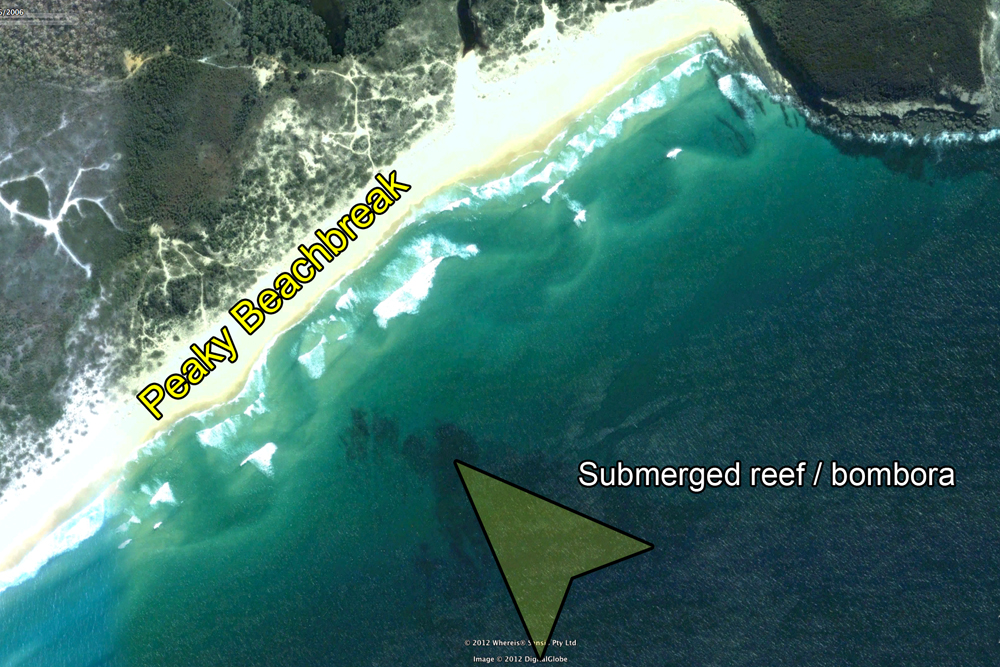The Mechanics of the Sand Slug

Recently Swellnet posted an article on the 'Sand Slug', an artificial seamount currently being constructed at Cronulla. The Sand Slug is composed of waste sand dredged from the nearby Hacking River and if it works as planned will improve the wave quality. It is a new concept and very much an experiment. The following article by Craig Brokensha provides an explanation of the science behind the Sand Slug.
Many are the ingredients that go into forming a great beachbreak: coastal alignment, sandflow, and exposure to swell being just a few of the elements required. Another factor, and until recently it's been mostly overlooked, is the presence of an offshore bombora or seamount that alters the approaching swell lines.
These type of beachbreaks have been called 'bombora controlled beachbreaks'. A term coined by coastal engineer, Andrew Pitt.
Good examples on the east coast are Manly under an east or north swell (due to Queenscliff Bombora), Tuncurry Beach (due to the offshore bar) and Duranbah under a south swell (due to the Tweed River bar). In Victoria 13th Beach is another classic example.
Looking deeper into why these offshore features affect wave quality we have to understand that unbroken waves carry and hold their energy below the water surface. The larger the swell period, the deeper the energy reaches.
As a swell approaches the coast it begins to 'feel' the ocean floor (bathymetry), slowing down and bending toward the shore. This results in most swells – barring weak windswells – striking the coast square on. Long closeouts are the result unless there's a quality sandbank or reef to focus the swell onto.
On the other hand, if we have a submerged sea mount or reef (visualise an under water hill on an otherwise flat plane) sitting offshore we get a phenomena where the waves will feel the sea mount and bend in around it causing a criss cross of swells that will then arrive on the beach. This is likely to produce multiple ramps and wedges as the criss crossing swells combine, with the maximum energy and wave activity occurring in line with the offshore sea mount.
In this way an otherwise boring beach full of closeouts is turned into a surfers playground.

Herein lies the theory behind the Cronulla sand slug. The Bate Bay Sand Placement Committee (which includes the aforementioned Andrew Pitt) working in co-operation with the Sutherland Shire Council are dumping a mound of sand approximately 300 metres offshore from The Wall at Cronulla. While it is in place the mound of sand – or sand slug – should imitate the effects of an offshore sea mount or reef.
In theory the sand slug will break up incoming swell lines and provided a series of wedges and peaks on the downward side of the slug. What can also be theorised is that the combination of swells meeting each other on the other side of the slug will generate larger than normal waves than if it wasn't present due to constructive interference, hence getting the most out of even the smallest swells.
Andrew Pitt and his team expect an A-frame peak to form on the beach side of the slug, with beach nourishment occurring in front of The Wall as sand from the slug slowly disperses shoreward. //CRAIG BROKENSHA
Sand Slug quick facts:
-The sand is dredged from the nearby Hacking River. It would otherwise be dumped randomly at sea. -There is approximately 70,000 cubic metres of sand to move from the river. -Dumping is expected to continue for eleven weeks. -The area of the dumpsite is approx. 100m wide and 200m long in a depth of between 4 to 6 metres directly offshore from The Wall.


Comments
Ahhhh! Finally, comprehension dawns! Thanks Craig.
If this effort works there are a few other places similar things could happen. When they dredge the Tweed Channel up here the spoil is getting dumped in Coolangatta bay and that is supposedly the cause of deteriorating wave quality (too shallow). If the dredges sailed 1 or 2 k's north to North Kirra or even Tugun they could create good beachbreaks there which would also ease the crowd at Snapper.
Craig - how long would the slug of sand be expected to remain in place/effective?
Hi Pensky, a similar question was asked by Stu in this article http://www.swellnet.com.au/news/2462-cronulla-s-latest-surfspot-all-new-... and Andrew provided this answer..
Q. So assuming average conditions how long should the sand slug last?
A. It'll all depend on Mother Nature. If we get a storm – ten foot and onshore with wild rips – it could chew it apart in a day. But the concept of a sand slug...it's actually a technical term meaning a body of sand that moves together as one unit. What we would like to see is that body of sand stay as one unit, and if it does disperse it will disperse in a shoreward direction. I'm hoping it will last three to six months.
-----
So idealistically it would be better to see reduced swell activity during the dumping to allow it to all take shape, but a big storm swell could tear it away in a couple of days.
Lets hope the latter doesn't happen any time soon.
Prattes Reef